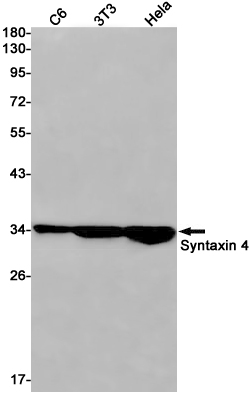
| WB | 1/500-1/1000 | Human,Mouse,Rat |
| IF | 咨询技术 | Human,Mouse,Rat |
| IHC | 咨询技术 | Human,Mouse,Rat |
| ICC | 技术咨询 | Human,Mouse,Rat |
| FCM | 咨询技术 | Human,Mouse,Rat |
| Elisa | 咨询技术 | Human,Mouse,Rat |
| Aliases | p35 2; PLACENTAL; Stx4; STX4A; Syntaxin 4; syntaxin 4A |
| Entrez GeneID | 6810 |
| WB Predicted band size | Calculated MW: 34 kDa; Observed MW: 34 kDa |
| Host/Isotype | Rabbit IgG |
| Antibody Type | Primary antibody |
| Storage | Store at 4°C short term. Aliquot and store at -20°C long term. Avoid freeze/thaw cycles. |
| Species Reactivity | Human,Mouse,Rat |
| Immunogen | A synthetic peptide of human Syntaxin 4 |
| Formulation | Purified antibody in TBS with 0.05% sodium azide,0.05%BSA and 50% glycerol. |
+ +
以下是3篇涉及Syntaxin 4抗体的经典文献概述:
---
1. **文献名称**:*"Syntaxin 4 mediates exocytosis of GLUT4-containing vesicles in adipocytes"*
**作者**:Tamori, Y. et al.
**摘要**:研究利用Syntaxin 4抗体证明其在脂肪细胞中调控含GLUT4囊泡的胞吐作用,揭示其在胰岛素刺激的葡萄糖摄取中的关键功能。
---
2. **文献名称**:*"Targeting of Syntaxin 4 to the plasma membrane is required for cardiac muscle cell survival"*
**作者**:Hong, W. et al.
**摘要**:通过免疫荧光和Western blot分析(使用Syntaxin 4抗体),发现Syntaxin 4在心肌细胞质膜定位对细胞存活至关重要,缺失导致细胞凋亡。
---
3. **文献名称**:*"A role for syntaxin 4 in regulating SNARE-mediated membrane fusion during platelet secretion"*
**作者**:Feng, D. et al.
**摘要**:研究发现Syntaxin 4抗体阻断实验可抑制血小板分泌过程中的膜融合,表明其通过SNARE复合体调控分泌功能。
---
**备注**:如需获取具体文献,建议通过PubMed或Sci-Hub输入标题或DOI查询全文。若需要更近期研究,可进一步限定年份筛选。
Syntaxin 4 (STX4), a member of the SNARE (soluble N-ethylmaleimide-sensitive factor attachment protein receptor) family, is a key regulator of membrane fusion events in intracellular trafficking. Predominantly localized to the plasma membrane, Syntaxin 4 facilitates vesicle docking and exocytosis by interacting with partner SNARE proteins like SNAP-23 and VAMP2/3. It plays critical roles in insulin-stimulated glucose uptake in adipocytes and myocytes by mediating the translocation of GLUT4 vesicles to the cell surface. Dysregulation of Syntaxin 4 has been implicated in metabolic disorders such as diabetes and obesity, making it a target for studying insulin resistance mechanisms.
Syntaxin 4 antibodies are essential tools for investigating its expression, localization, and function in cellular processes. These antibodies are widely used in techniques like Western blotting, immunofluorescence, and immunoprecipitation to detect Syntaxin 4 in various tissues, including skeletal muscle, adipose tissue, and pancreatic β-cells. Specificity is a key concern, as Syntaxin isoforms (e.g., Syntaxin 1-3) share structural homology; high-quality antibodies are validated using knockout controls or siRNA-mediated silencing. Commercial Syntaxin 4 antibodies are often raised against unique epitopes within the N-terminal or C-terminal regions to ensure isoform selectivity. Research applications span diabetes, neurodegenerative diseases, and membrane trafficking studies, reflecting Syntaxin 4’s broad regulatory roles. Recent studies also explore its involvement in immune cell secretion and cancer metastasis, expanding its biomedical relevance.
×